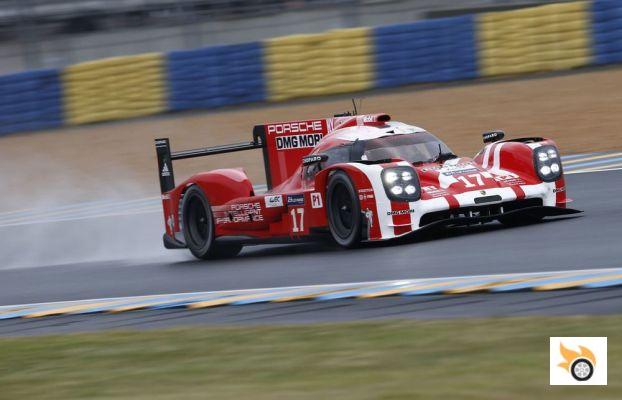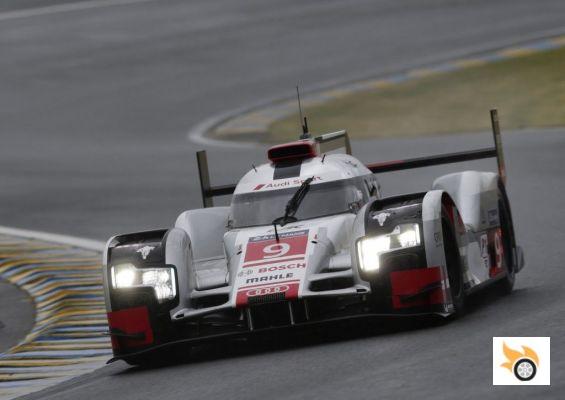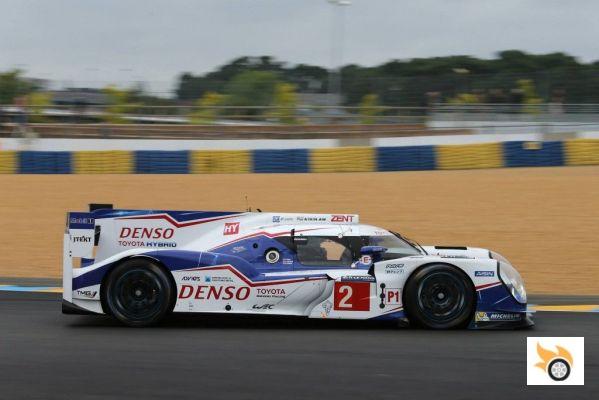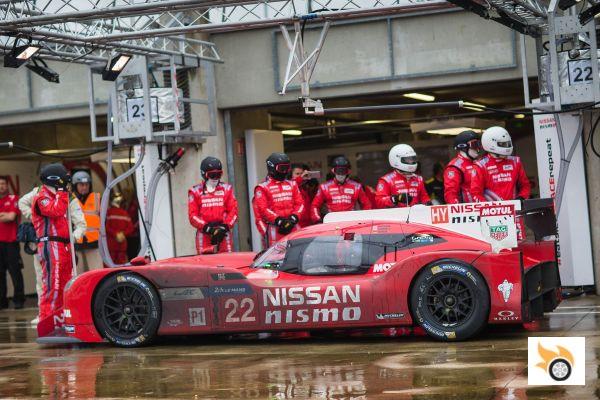But before we get down to the nitty-gritty to tell you what happens on each day and at each moment, I thought it would be a good idea, within the super special that Nissan has allowed us to do on this 24 Hours race, to give you a virtual tour of all the LMP1-H that will fight for victory this weekend, explaining their technique in brief, their strengths, their weaknesses, and making my own predictions about their race pace, their speed on a lap and their potential to win. Do you want to discover it?
Porsche 919 Hybrid

| Model | Porsche 919 Hybrid 2015 |
| Category | LMP1-H 8MJ |
| Combustion engine | V4 petrol, direct injection and turbocharged with fixed geometry turbocharger, 2 litres displacement |
| ERS (energy recovery systems) | Two, a kinetic energy recuperator on the front axle, and an exhaust gas energy recuperator installed in the tailpipe system behind the conventional turbocharger. |
| Recovered energy storage | Liquid-cooled lithium-ion battery with capacity of approximately 1.2 MJ, manufactured by A123 |
| MGU (electric motor drives) | A single electric motor on the front axle coupled to the wheels by means of drive shafts, rated at 500 hp |
| Weight | 870 kilograms (minimum by regulation) |
| Maximum power | 500 horsepower from the combustion engine + more than 400 horsepower from the electrical system (MGU), nearly 1,000 horsepower in total |
| Target lap time at Le Mans | 03:14:00 |
| Laps per stint between refuelling | 14 |
| Stints possible with the same set of tyres | maximum of three |
| Mechanical layout and type of traction | All-wheel drive, with longitudinal mid-rear engine and MGU positioned on the front axle |
The fastest machine this week is not going to be the Audi R18 e-tron. It's going to be the Porsche 919 Hybrid, hands down. The 919 Hybrid has been completely revamped for this season, and it's already proven to be fast over a lap last year.
Although the car looks similar to last year's, most of its components are completely new, starting with the chassis, which has become a single piece, allowing weight savings. From the weight savings in the upgraded chassis comes the ability to pack more A123 cells into the battery pack and be able to accumulate up to 700 kJ in the battery, allowing the car to run in the 8 MJ category, which automatically gives it a competitive advantage in lap times.
The combustion engine also gets a major overhaul, improving in many ways to reduce fuel consumption, avoid last season's vibration problems and better coordinate its operation with the turbocharger and the electric tailpipe generator. The electric exhaust generator is independent of the turbocharger unlike the solution used in Formula 1, as Porsche believes that this way it favors reliability by reducing the temperature of the component and to play with more or less energy regeneration at all times. Porsche says that the use of a combined MGU-ERS unit and integrated into the turbocharger as used in F1 was something interesting to evaluate, but that their analysis says it does not represent an improvement in exchange for the potential loss of reliability.
Aerodynamically the car changes, especially for Le Mans, with a concept of aerodynamic work in the front more evolved, looking for less friction with the air and more work by the diffusers. The rear of the car has had to change by regulation and forget about its flexible engine cover, now forbidden by regulation.
At the suspension level, and in relation to aerodynamics, the car uses an interconnected front and rear suspension system to control the pitching of the car. Aerodynamically it is particularly interesting to maintain a consistent angle between the flat bottom of the car, the diffusers and the tarmac, and by using these systems (called FRICS in F1, where they were banned last season), the cars manage to control the pitch and minimize it, resulting in a more consistent downforce.
The potential of the car is undeniable. Talking to people from the project and Le Mans experts, we have been able to guess that the 919 Hybrid could lap in 3:14 around the La Sarthé circuit in qualifying, if Porsche wants to get the most out of it. Race pace will be closer to 3:20, but in either case, the car is by far the fastest on the grid and probably the favourite to win, even ahead of Audi.
The problems with the car? Basically two. On the one hand, there is the issue of tyre management. It is foreseeable that, without factoring in technical problems that will arise during the race, Porsche will spend more time in the pits than Audi. Its tyre consumption is higher, and it also has another associated problem, and that is that the 919 Hybrid degrades the tyres faster, which makes the lap-to-lap pace degenerate more quickly. Overall, adding up the lap times of all the laps of a triple stint with the same tyres, the result is a total time that could be equal or worse than the Audi. This is really where the race will be decided, if the weather factor and rain tyre management doesn't become another vital aspect.
On the other hand there is the issue of reliability. The 919 Hybrid is still a car more prone to failure in 24 Hours than the Audi, simply because of the lack of mileage on a car that is brand new (the Audi is a redesign of the 2014 car).
My personal bet? Until I learned about the 919's lap time potential, I was giving it as "second best", giving the R18 e-tron as the favorite. But knowing now its true potential, I really think it is the car that can dominate Le Mans 2015, if the team knows how to manage the tires and the reliability and weather respect them.
Audi R18 e-tron 2015

| Model | Audi R18 e-tron 2015 |
| Category | LMP1-H 4MJ |
| Combustion engine | 120° diesel V6, four-liter displacement, direct injection, variable geometry Garrett turbocharger |
| ERS (energy recovery systems) | One, MGU-ERS on front axle, kinetic energy recuperator linked to front wheels via two axle shafts. |
| Recovered energy storage | GKN electromagnetic flywheel system with 700 kJ storage capacity, installed in the passenger seat. |
| MGU (electric motor drives) | A single electric motor on the front axle coupled to the wheels via axle shafts, rated at over 270 hp |
| Weight | 870 kilograms (minimum by regulation) |
| Maximum power | 560 horsepower from the combustion engine + more than 270 horsepower from the electric system (MGU), about 830 horsepower in total |
| Target lap time at Le Mans | 03:16:00 |
| Laps per stint between refuelling | 13 |
| Stints possible with the same set of tyres | four or five |
| Mechanical layout and type of traction | All-wheel drive, with longitudinal mid-rear engine and MGU positioned on the front axle |
Last year the R18 e-tron was not as fast as Audi would have liked. In the WEC it was dominated by Toyota, and at Le Mans they won because of their brilliant strategy management and reliability.
This year has retained the technical heart of the car, running with the same chassis and a new evolution of the propellant, which despite having less fuel flow, by the promotion of energy category of 2 MJ to 4 MJ, is more powerful than last season. But the big news is in aerodynamics.
Audi has a specific design of the car for Le Mans, with a lower aerodynamic penetration bodywork, with solutions as curious as the mirrors integrated into the front wheel arches. Originally one of the ideas Audi wanted to explore was to work with the air going through the front, rather than deflecting it. Audi wanted to take the air in the area of the headlights to create aerodynamic curtains on the front wheels and reduce drag, something we've seen them do in the WEC, but during testing two weeks ago at La Sarthé, the team ended up covering the air intakes on the nose of the car, and worked without this concept, which we assume we won't see this week in France either, barring a surprise.
The rest of the car has far fewer elements than in the past, with the bodywork focused on gently massaging the air over the bodywork and giving little work to the rear wing. The downforce is concentrated in the underbody, in the diffusers, and to maximize its effectiveness, the Audi uses, like the Porsche, an interconnected system of front and rear suspension (FRIC) with which to maintain the angle of attack of the car consistently.
Audi says that the 2015 car has managed to employ a flywheel that is capable of storing 700 kJ, and that it weighs no more or takes up no more space than the previous year's car. The same goes for the MGU. Thanks to competing in a higher energy category, the car is immediately almost two seconds faster, it is also more efficient, and can offer all-wheel drive more continuously (last year's two megajoule limitation meant that in some corners the car was all-wheel drive, and in others, with no energy available in the flywheel, it behaved like a rear-wheel drive).
Overall the car has less peak power than all its class rivals, but it plays with the diesel advantage: it has more torque at the wheels and, at least in theory, should play with less fuel consumption than the others.
On paper, it is the most consistent car in the lap-to-lap (the one that makes more even times throughout a stint), the one that takes better care of the wheels, and the only one that is able to combine both aspects in a package fast enough to compete with Porsche on equal terms. The fight will be very close, and Audi will have to defend itself with more strategic wisdom, better management of its resources and greater reliability, at least on paper, as it is the car that has changed the least since last year.
Toyota TS040 Hybrid 2015

| Model | Toyota TS040 Hybrid 2015 |
| Category | LMP1-H 6MJ |
| Combustion engine | Japanese SuperGT-derived 3.7-litre naturally aspirated petrol V8 with direct injection |
| ERS (Energy Recovery System) | Two combined MGU-ERS, one on each axle, front MGU-ERS manufactured by AISIN and rear MGU-ERS manufactured by DENSO |
| Recovered energy storage | Supercapacitor system manufactured by NISSHINBO with about 1 MJ of capacity |
| MGU (electric motor boosters) | Two electric motors, as mentioned above, with about 500 hp combined between them |
| Weight | 870 kilograms (minimum by regulation) |
| Maximum power | 500 horsepower from the combustion engine + 500 horsepower from the electrical system (MGU), about 1000 horsepower in total |
| Target lap time at Le Mans | 03:18:00 |
| Laps for each stint between refuelling | 13 |
| Stints possible with the same set of tyres | four |
| Mechanical layout and type of traction | All-wheel drive, with longitudinal mid-rear engine and an electric motor fitted to each axle |
If there was a chance for the TS040, as we know it, to win Le Mans, it seems to have been last year. It was the fastest car on track, with greater reliability than the Porsche 919 that could challenge it on that feature, and with fuel consumption and tyre handling equivalent to the R18 e-tron.
But Le Mans 2014 was not Toyota's year of victory, and it had to settle for third place. Last year's problem can be put down to the Japanese team's stubbornness in taking only two cars to the race, instead of three. The #8 car crashed in the wet, and the #7 car had to fight for the win alone until an electrical failure took it away, when it was the fastest and most effective car on track. Not having a third spare car there weighed on them, as the technical problem was not something common to all TS040s...
Toyota thought that having such a fast car, improving it a bit would be enough to keep it competitive, after taking the WEC title in 2014. The new TS040 renews 80% of its parts, but without major new approaches. The idea was clear: keep the strengths of the car, reliability, evolve the concept and gain something in aerodynamics.
But reality has been cruel to them. When they got to the track they found that their car has improved its race pace by almost three seconds compared to last year, which is not bad at all. But the problem is not in that, is that both Audi and Porsche have made a giant leap. Toyota is still unable to compete with 8 MJ in its energy category, which costs it almost two seconds over Porsche, which last year already had its ear to the ground in speed, and this year with more electrical energy available and a bestial aerodynamic improvement is almost four or five seconds ahead in pace per lap.
Audi has also improved more than expected by the Japanese, and has an advantage of two or three seconds per lap. And all because Toyota has problems with its supercapacitor. From what we've been able to find out, packing the 8 MJ meant using a supercapacitor of more than 1.2 MJ capacity, and that made the car heavier than the 870 kilos set by the regulations.
Switching to a lithium battery system seemed the most sensible option, as well as creating a more efficient combustion engine, but Toyota has left that for later, and has paid for it this year with a relative loss of performance, while the Germans soared in pace.
As it is, the TS040 Hybrid won't be able to fight this year on speed. Looking at the history of Le Mans, the fastest car on track doesn't always win, but the problem for Toyota is that there are six, no less than six cars faster than their pair of TS040s. The Japanese will have to pray for rain and play with strategy to try to fish in troubled waters. They have it very complicated.
Nissan GT-R LM Nismo

| Model | Nissan GT-R LM Nismo |
| Category | LMP1-H 8MJ |
| Combustion engine | Three-litre direct injection petrol V6, twin turbocharged and turbocharged, built by Cosworth for the occasion |
| ERS (Energy Recovery System) | A central kinetic energy recuperator, linked via axle shafts to the front axle exclusively |
| Recovered energy storage | Dual Torotrak Flybrid flywheels installed under the driver's feet, with an original capacity of 2 MJ |
| MGU (electric motor drives) | Mechanical coupling between flywheel system and front axle (rear axle has been decoupled for the race finally) |
| Weight | About 880 kilograms |
| Maximum power | 600 hp from the combustion engine + 600 hp from the flywheel, for a total of around 1,200 hp |
| Target lap time at Le Mans | 03:25:00 |
| Laps per stint between refuelling | 14 |
| Stints possible with the same set of tyres | Total unknown |
| Mechanical layout and type of traction | Front-wheel drive, with longitudinal front engine and flywheel under the driver's feet |
When it all works out in 2016 (if it ever does) the GT-R LM Nismo will be feared by all the competition, both at Le Mans and any other WEC event that consists of fast, high downforce corners (we'll talk about that tomorrow or the next day, by the way). The simulations say that the GT-R LM Nismo, with its all-wheel drive working and the flywheel system at full power, will have more than 1,650 horsepower, enough downforce to get it to the ground, and a lower Cx than its rivals, which should allow it to do the lap of La Sarthé in less than 3:15 and reach 360 per hour on the straights, while consuming the same or less than its rivals.
But lack of time, lack of mileage and problems with such an innovative invention have meant that Nissan arrived at Le Mans with its homework undone. Bowlby and Cox have already openly acknowledged that they won't be on their rivals' times, although Bowlby has promised that his car will run "close to the pace of last year's winners". Our research puts the GT-R LM Nismo at 3:25 per lap at best.
Gone by the wayside is the all-wheel drive system (it will run front-wheel drive only at Le Mans), and although the car was homologated for the 8 MJ category, it's only capable of recovering and delivering 2 MJ per lap in the race, which weighs down its race pace.
We don't have references about its tyre durability (it is said that it destroys rear wheels in slow corners, when it lifts up "the duck" and flats) and neither about its fuel efficiency. But what we do know is that it will not be in the fight for the victory, unless there is an epic hecatomb of the eight cars of the other three official teams, and they will have to accumulate experience and knowledge giving the maximum number of laps possible. Priority therefore? To run "slowly but surely" and to break as little as possible so that this race test will be productive for the development of the car.
The fact that they are ahead of the non-hybrid LMP1s of Rebellion and Kolles I think it could be considered a success for Nissan, in fact.
The return of Alfa Romeo: from the 1900 to the Giulia




























